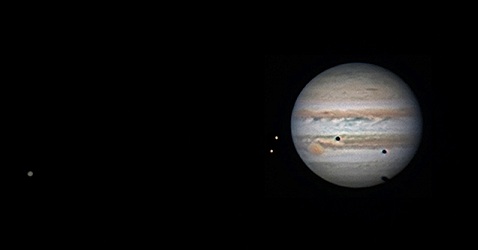Posted On: Tuesday - January 22nd 2019 7:48PM MST
In Topics: Geography Science
(... continued from Part 1)

Now, back to Astronomy, here's where it came into play in the quest for accurate longitude. Things in "the heavens", as Astronomers still use the term today, happen at a certain time, and differences in the observing location on Earth are negligible (with the exception of fairly near events like our own moon's and sun's eclipses). What those Galilean moons turned out good for, as they are very easy to observe, is for basically getting time checks. To get a time check to within a few seconds, the astronomical event had to be something precise, so the best were eclipses involving Io, Europa, Ganymede, and Callisto and the big Kahuna of planets they orbit, Jupiter.
Note that both kinds of eclipses work here. The non-dogfood-related ALPO, the Association of Lunar and Planetary Observers, has a great short informative .pdf here! As one of these moons (in the ballpark, in size, of our moon, but with a planet 10 X bigger in diameter, hence diameters ~ 2-3% of that of their planet) enters the shadow of Jupiter, it can blink out within 4 minutes to a couple of hours (for the Callisto, the outermost/slowest). That doesn't sound like great accuracy, but that's the total eclipse time. As the moon enters the shadow of Jupiter, light fades slowly - that's no good. However, as an observer, whether in the 1500's or 2019, watches, the last light can be timed to with a second or so. That translates to a value of longitude within (1 hour = 15 degrees, so 1 second of time = 15/3,600 degree = 15 arc-seconds (note: not time units, but angle)), or more commonly stated, 15 seconds of arc. That is 1/4 mile at the equator and more accurate with increasing latitude, going as 1/4 mile x cos(latitude). However, come to think of it, that number is only as good as the regular sextant star-shooting angle is, but it would allow as good as one could get for latitude or that 1/4 mile x cos(latitude), whichever is larger.
Do you see how it works? It doesn't matter where you are, an eclipse of Io happens when it happens, ANYWHERE. Even if the sailing expedition did not have the ephemeris charts from the Astronomers of the Royal Society in London with them, with the predicted times of these eclipses, the position of any known star would have been shot by sextant and logged*. That's the key. The calculations of the position of that expedition could have been calculated after the fact, maybe many months later, back in a cozy pub in Genoa, Lisbon, or London. The maps could be made then.
On the other hand, if an expedition DID have the astronomical charts on them, which helped Cristobal Columubus' crew stay alive on Jamaica on their 4th voyage, then longitude, hence, accurate position, could be determined on the spot (OK, maybe after a few minutes or an hour of calculations). I would imagine that this way would be loads better, as decision-making for the voyage could be made with real-time position information.
It's a bit out of order here, but I did mention BOTH kinds of eclipses. For a planet that big, with moons ~ 2-3% the size of it, a solar eclipse there would be in the form of a transit of a shadow across Jupiter's disk, probably not visible with Galileo's original telescopes. One would need 100-power, or more importantly, a lens or mirror big enough to RESOLVE 100X. Shadow transit observations are not as accurate as the lunar eclipses described above, as the timing of a dark spot appearing on one edge, or the disappearing on the other edge is inherently not as easy to pick out. BTW, there are the two other types of events, a transit of one of the moons itself across Jupiter's disk, and a disappearance (occultation) of one behind the disk, with a reappearance later. Both of these latter two sets of events are difficult to time due to trying to make out a bright object on another, or next to another.
After all was said and done, the accurate Harrison clock, the invention of which is described in that book, won out. However, Astronomy had its place in the sun, for a purpose that one had to be clever to even think of. What a time of enlightenment, indeed!
Wait, what? Where's my stupidity?!!
Hey, we are fresh out for tonight. Don't be alarmed, readers, as from our normal daily analysis of stupidity, it is as vast as the Universe itself, with billions and billions of metric shit tons spread out over the galaxies, dating all the way back to a few months before the big stupid-ass bang!
* Information like this, along with all that other botanical and anthropological knowledge gained, would all be in the ship's scientist's logbooks, and this explains why those would be just as valuable as gold and spices to some enlightened Westerners back at home.
Comments: